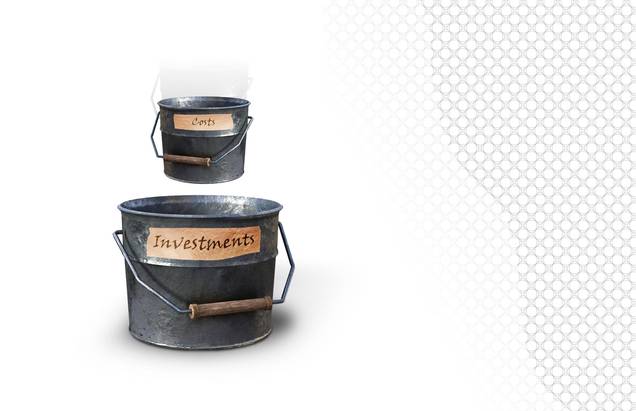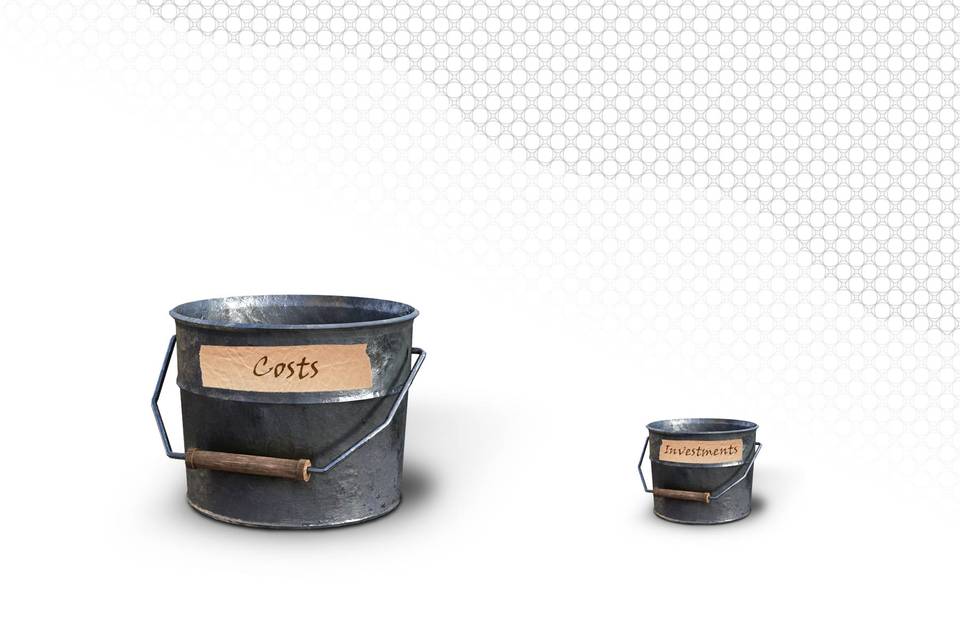To avoid any confusion, let me define the two buckets of Costs and Investments first. I consider it practical to view both concepts as an expense, because they both require an allocation of resources. What sets these two buckets apart is the nature of and attitude towards its contents. The Costs bucket holds all the operations-related, compulsory expenses. The Investment bucket holds the growth-related, optional expenses.
If you don’t hire an accountant you might end-up paying improper amount of taxes which could render your firm obsolete — a compulsory expense. If you don’t allocate resources to online ads today you might not get new clients next month — an optional expense. The contents of each bucket determine the severity of consequences.
What gets into either of the buckets in the first place is rather interesting. The sorting typically happens somewhat intuitively. Expenses like furniture, stationeries, printing paper, laptops, website, accountancy and legal services (and so on) tend to get into the Costs bucket; marketing campaigns, ads, email blasts, employee training and seminars (for example) land in the Investment bucket. The former bucket is usually several times bigger than the latter one.
But what if this intuitive sorting is the wrong kind of approach?
Profit growth is obviously one of the primary objectives of any business entity. There are two simple ways to increase absolute profits: reduce costs and increase revenues. We could also tackle the cost efficiency / productivity issue but how to do that isn’t always obvious and is therefore often times left unattended. To grow revenue we need to increase the size of the Investment bucket. To reduce costs we need to defund the constituents of the Costs bucket.
If the management decides to cut costs in order to increase the profits, anything that gets inside the Costs bucket will automatically be considered as a candidate for a reduction.
“What’s in the costs bucket: stationeries, furniture and employee salaries? Well, we can’t decrease salaries much, let’s cut on paper, chairs and desks — spend less on everything!”
Wait, but what happens if we start spending less on accountancy and legal support? Could it be that we might end-up hiring a service provider so incompetent that it would cost us significantly more than the perceived savings from the cost reduction? Maybe accountancy and legal should not be in the Costs bucket after all?
If that is the case then what about other expense like our website and printing paper? Are we going to purchase the cheapest, thinnest paper that gets constantly jammed in the printer? Or it would be more prudent to pay extra 30% and rid our employees from the frustrating necessity of having to regularly fix the paper tray?
It looks like it isn’t that obvious or intuitive which of the expenses belong where.
Let’s consider a website for a professional services firm as a case study. Typically every small to medium size company (except e-Commerce and any online business model) considers their website as a necessary evil rather than a horn of plenty. Therefore the website lands in the Costs bucket.
If you ask any competent web designer or web developer they would admit that more than half of business websites suck. I have personally analyzed over 550 websites in five months and have come to the same conclusion.
We also did a research of over 60,000 websites only to find that 39% have issues even with basic-level SEO. Obviously, most of the companies consider their websites as a Cost rather than Investment.
But if you were to consult an expert, they’d tell you that your company website is an incredibly potent sales/marketing tool and is therefore worth paying attention to. They would recommend allocating $30k — $50k in getting the website up and running in six months. They would also recommend redesigning it every five years.
I don’t want to get into websites’ utility in this article. The point I was trying to make is that not everything that we intuitively consider to be Costs should actually belong in the Costs bucket. It takes time, effort and competence to make a considered decision about what goes where.
We shouldn’t get rid of the Costs bucket entirely either. This bucket is really important; make no mistake about it. Being aware of what really belongs in it is essential to knowing where you will be able to draw resources from in times of need without jeopardizing the future of your firm. The Investment bucket, however, must be bigger.
But what if we don’t have to have two standalone buckets either?

Instead of swapping labels on the buckets making the Investment bucket larger, perhaps it would be more prudent to have just one single bucket of Investment placing a smaller one — the Costs bucket — inside of it? The default approach to any expense could be in seeing it as an Investment first and then testing how big of a Cost component there is to it. Not the other way around.
“Our ABC expense is a typical cost but if we were to invest more resources in it, we could benefit in XYZ ways. Right now we can’t afford to purchase an expensive printing paper, but given the opportunity we will invest 30% extra to attain the benefits of having it.”
How does that fit into the bigger picture of building a Brand? Well, if you are creating a luxury sort of brand then it makes total sense to pay premium for better stationeries, furniture and website, doesn’t it? Your clients should notice no dissonance between your claim of eliteness and the tools your company uses to ensure it.
The same is true for cost-efficient offerings. The efficiency is achieved through management and allocation of resources. If the cheap printer gets constantly jammed due to it being, well, cheap and fed with thin inexpensive paper, your employees will end up spending their productive work on fixing it and then, additionally, dealing with low morale. There is no real efficiency in that.
Regardless of the type of business you’re in or the brand you’re building it makes sense to start seeing expenses as Investments first.
We have developed a model that helps with qualifying business decisions — the Swan-Crawfish-Pike model. It will help you determine how much of an Investment component there is to the the planned activity at hand.
The awezzom question of the day:
Does this Investment in (_________) belong in the Costs bucket?

